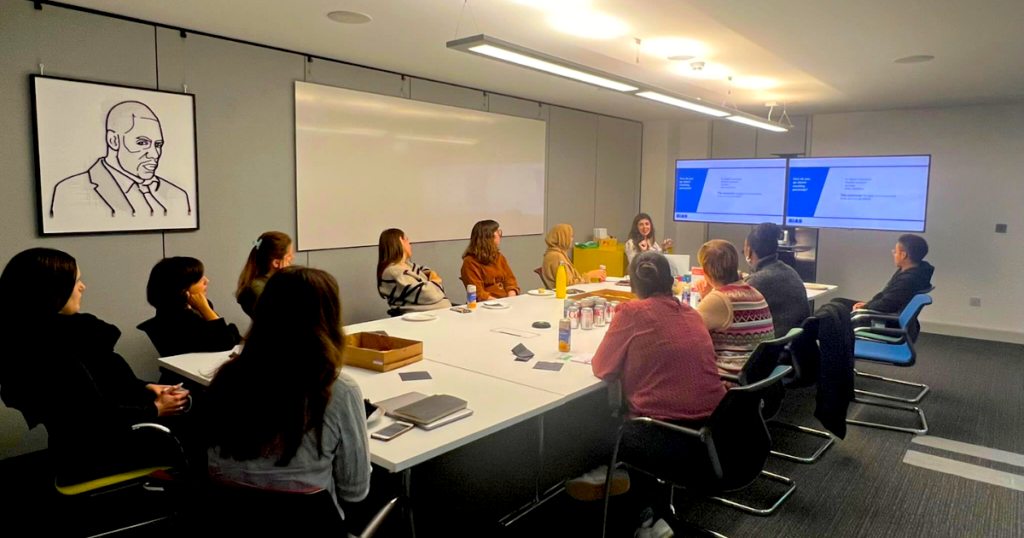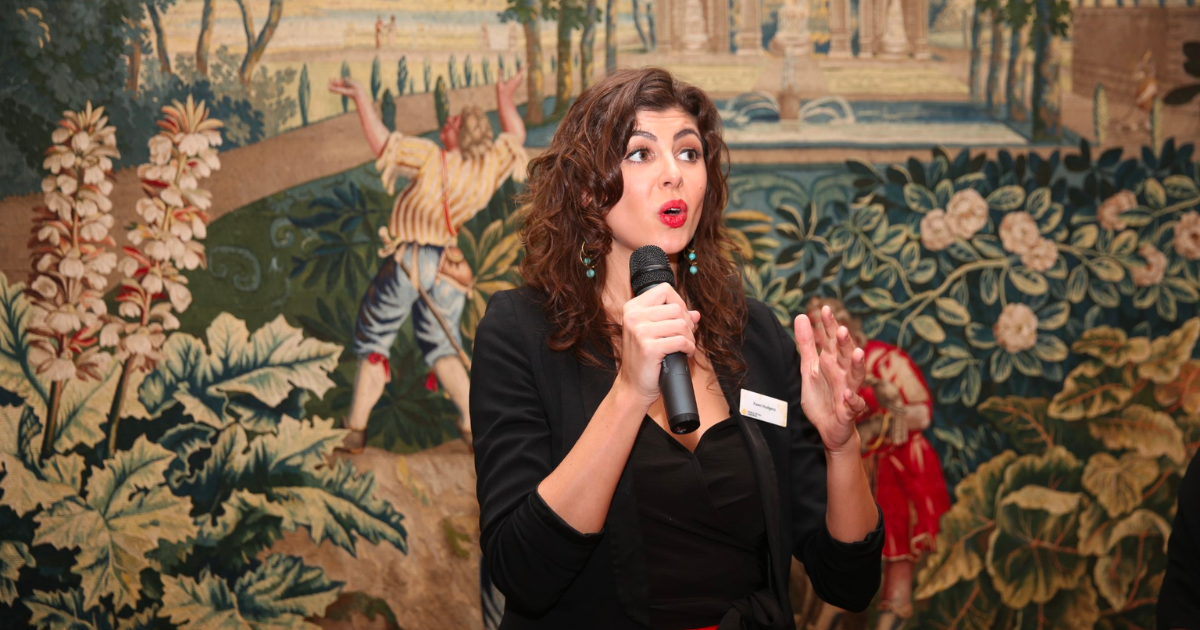“Newsflash: You are not the hero of your brand story”
Plexal workspace member Fawn Hudgens of Digital BIAS led our Women in Business session on mastering storytelling in Stratford this November. Digital BIAS works with Marketing, Sales and Product teams in B2B Saas and Fintech, helping to scale businesses by optimising go-to-market strategy, customer acquisition and sales processes and product onboarding. With over a decade of experience in product marketing for major brands, Fawn shared the fundamentals needed to craft a great business story.
As VP of Marketing at Digital BIAS, Fawn leverages the power of strategic brand storytelling daily and our members used this opportunity to gain valuable insights into this pivotal business skill.
“We’ve been telling stories since time began; we have evidence of stories 35,000 years ago in caves in France,” Fawn began. “All cultures, throughout time, tell stories. They are our most fundamental way of communicating and connecting. As such, you’d think it’d be easier, but we find that businesses are in such a rush to get to market, they forget to do the hard work that sets them up to successfully convey their story.”
Fawn aimed to build a solid foundation on the topic for our members by presenting the five fundamentals of business storytelling:
- Who’s the story for?
- Walk in their shoes
- What’s your take?
- You are not the hero
- What have you learned?
Who’s the story for?
Starting with step one: Building a story about your buyer. This helps you to understand who’s receptive to your product or service, who will ignore you (and why), which aspect of your solution is relevant, what attitudes prevent a customer from buying and which buyers are involved in the decision – along with how much influence they wield.
To break this down, we learnt about buyer personas, which is a semi-hypothetical picture of your ideal customers based on real data and insights about your target audience. To create personas, you need rich data from market research, conducting in-depth interviews, distributing surveys and analysing your web data. As a result, you’ll start to see patterns across job titles and you should end up with no more than five or six personas. This is crucial as you need to understand your customers’ needs, why and how they’re making purchase decisions and determine the best way to approach them with your offering.
“Why is this important?” Fawn asks. “Because you can’t meet a customer’s expectations if you don’t know them. And expectations are higher than ever.”
This is backed up by the stats:
- 64% of buyers expect personalised engagement based in previous interactions
- Of these, 48% are more likely to choose solution providers who market to their specific needs
- 63% of customers are more likely to engage and respond to personalised messaging over static
- 77% of customers have selected, recommended or paid more for a company that provides personalised experiences
Walk in their shoes
At this stage, we dove into the jobs-to-be-done framework whereby you build an offering based on understanding both the customer’s specific goal or “job,” and the thought processes that would lead that customer to “hire” a product or service to complete the job. This aims to find out what your users are proactively trying to accomplish or achieve when they buy your product or service, understanding the big question: why do they need you?
Mapping out your buyer’s journey is also key. Fawn outlined that today’s B2B buyer’s journey is much more complex and nonlinear so understanding which of your personas are where in the buying process and what content they need at that stage to move them down the funnel is vital to relationship building and ultimately conversion.
The average buying committee has at least six stakeholders, and each one brings around four pieces of independently researched information to the table, she notes. “This is why it’s especially important that marketing, customer success and sales are all telling the same story and speaking the same language and telling the same story – or you’re making it even harder to get a deal over the line. Consistency of messaging builds trust and clears the path forward more quickly.”
What’s your take?
“What was the differentiator, opportunity, or status quo that you were looking to change?” queried Fawn.
Most ideas aren’t unique. Fawn encouraged our members to think about what the “spark” was that’s different about their idea and what, ultimately, they learnt on their journey to build their offering. This serves as the foundation for your positioning and messaging. Positioning is internally defining how you are the best at something a market cares a lot about. Messaging is the external way you talk about your product to consumers, compelling them to act. These frameworks should underpin all marketing and sales messaging, including your website.
Authenticity is key to messaging. Quoting Brené Brown, a researcher and storyteller who’s studied courage, vulnerability, shame, and empathy, Fawn detailed, “Authenticity is…about the choice to show up and be real. The choice to be honest. The choice to let our true selves be seen.” This is what a great brand story reflects. Fawn noted this is harder for B2B brands but can still be achieved through your tone of voice and how you approach your story.
Adding her own input, Fawn expressed: “The story you want to tell or feel you need to tell is rarely the authentic one – often the story you should tell is.”
You are not the hero
In her specialism of storytelling, it was only natural for Fawn to bring in Star Wars to keep the presentation engaging, as she explained: “You are always, always Yoda. It’s your job to make your customer Luke Skywalker.”
“Newsflash: You are not the hero of your brand story. Always be the guide and try to have your buyer envision what their life could be like with your offering. Make them the hero.” But how do you achieve this? Fawn encouraged our members to search for a framework that works for them, whether Freytag’s pyramid or Storybrand’s Brandscript, noting there’s a surplus of great options available out there.
What have you learned?
Wrapping up the session, Fawn reiterated that building the foundations of storytelling is not a one-and-done job.
“We often get so busy that we go through these tasks like a tick box exercise,” she said. “We move on, forget about it. But your customer is changing all the time. So is your market. So are your competitors. You have to keep up with them. I recommend after your first initial testing and tweaking in the market, you revisit this about once a year.”
Iterate, test, learn, revisit. But why does this matter?
- 71% of CMOs don’t have the budget to execute their strategy (Gartner)
- Only 5% of your buyers are in-market at one time (Ehrenberg-Bass Institute)
It’s vital that given the business environment of strapped resources and limited opportunities, we make the most of our resources and target the right people at the right time with the right messaging at the right place in the buyer’s journey. Otherwise we are pushing messaging out there in the mere hopes of some sort of return. “Can any of us afford that?” Fawn asked.
Our members thoroughly enjoyed Fawn’s session, with many taking on the fundamentals of storytelling with them to apply to their own businesses and professional endeavours. One participant messaged us a few days later to say, “Thank you for this. I had a meeting this morning that I had been preparing for as the hero. I changed everything based on this presentation and they on the spot brought 3 of my projects with extras.”
If you’re a woman in business keen to share your experiences and collaborate with fellow workspace members, please speak to our Community Team who will gladly connect you.



